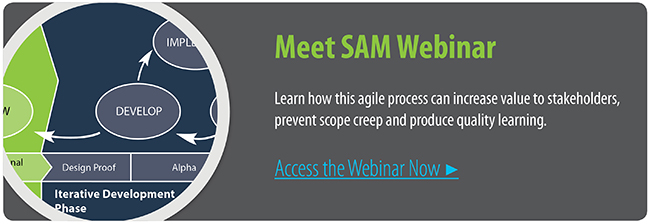Blog
Live from ASTD ICE - Day 2 Recap
by Angel Green, senior instructional strategist | @LearnerAdvocate


Training Design: Learning to Listen and Ask the Right Questions
By Angel Green | July 15, 2013 | Custom Learning | 0 Comments
by Angel Green, senior instructional strategist | @LearnerAdvocate
 A few weeks ago, Richard Sites and I had the unique opportunity to travel to Rio de Janeiro, Brazil to deliver a two-day Leaving ADDIE for SAM workshop. We were fortunate to have a great group of participants who were open and receptive to learning about how to improve their process to create learning events.
A few weeks ago, Richard Sites and I had the unique opportunity to travel to Rio de Janeiro, Brazil to deliver a two-day Leaving ADDIE for SAM workshop. We were fortunate to have a great group of participants who were open and receptive to learning about how to improve their process to create learning events.
Even though Richard and I came from a different continent, time zone, season, and spoke a different language, we heard frustrations echoing what we have been hearing across our industry. Their clients are demanding quicker (and cheaper) turnarounds for course development, the learners have been burned by information overload, and the stakeholders are looking to really improve the performance of their employees.
The participants we met with were eager to learn how the Successive Approximation Model (SAM) can help them avoid scope creep, shorten development time, and create courses which better address learner performance needs. The participants engaged in discussions and activities designed to help illustrate some of the key components of SAM. And again, another similarity was noticeable. Like many instructional designers, these folks were quick to jump to design for a problem described to them.
After working with literally hundreds of instructional designers over the years, I have noticed we (generally) share a set of common traits – the desire to fix a problem and the desire to please. It’s likely that is what makes us good at our job, but it can keep us from being great at our job. We hear of a performance problem, throw on our superhero cape, and set out to fix the world. We quickly come up with a training solution and get to designing it immediately. In essence, we dive right in without feeling the water or seeing how deep the pool is.
A rather powerful activity we conducted in this workshop is designed to showcase the power of questioning and listening. In the class, we present groups with a mock customer service performance challenge being faced by an organization. Our instructions to the participants are similar to the instructions we get from clients (even if they are our internal clients) – we have this problem, we want training developed.
The participants are given a flip chart, markers and the ability to ask us, their “clients”, some questions. As we started the activity, we received a few questions – who are the learners, do they have sound on their machines, do they have mobile devices, is there an LMS, what is the customer service metric we are looking to improve, etc.
All groups then jumped in and started designing an interaction they felt would help increase the customer service skills of the employees. Like most IDs, they checked the box of a learner and performance analysis and felt confident to move to design. The problem was that they ended the conversation when they switched to design. They didn’t ask us (the mock learner and client) what we felt was our challenge, what the consequences were of a mistake, what good performance felt like, looked like, or sounded like. Once they had the answers to their questions, they no longer needed us.
It makes sense. After all we, as IDs, are hired to solve a problem. Therefore, we often believe that we need to do this on our own, that we can’t burden our recent learners, subject matter experts, or stakeholders with design input – but that’s why they hired us! We’re the ones with the master’s degree in adult education, or years of experience developing training.
As our participants found out – and as you likely have in the past – by designing without the input of the learners and the stakeholders, you miss the mark.
Part of the beauty of SAM is the Savvy Start, which includes a number of roles providing input during those initial few days of brainstorming. But the real beauty of SAM is the involvement of those integral team members throughout the process. Those folks move with you, in tandem, through the process of designing and developing a final product. And the product is designed and developed in front of their expectations, not behind them.
While we may feel that we are burdening a number of people to create training, I encourage you to accept the help. Recognize that you do not know it all and that you cannot understand, recognize, or interpret the slight nuances which are necessary to designing a great, contextual interaction. Trust me, your e-learning, ILT, or performance support tool will be better from their involvement in the project – at all phases!

About the Author: Angel Green
Angel Green is a senior instructional strategist for Allen Interactions’ Tampa studio, where she is responsible for providing consultation and instructional design expertise to clients, partnering to build engaging, interactive learning experiences. With nearly 15 years of experience, Angel has worked for organizations such as IBM, MetLife, and PricewaterhouseCoopers, and holds both MS and BS degrees from Florida State University. An accomplished speaker, Angel has held positions as an adjunct instructor of public speaking and is past president of a Toastmasters International chapter. She also frequently blogs on Allen Interactions’ e-Learning Leadership Blog. Angel is the co-author of the Leaving ADDIE For SAM Field Guide. Find Angel on Google+.
Comments
Would you like to leave a comment?
Related Blog Posts

By: Angel Green | May, 2013
Category: Custom Learning, Digital Engineering, Strategic Consulting

Blog
My Learning Resolutions for 2013
by Angel Green, senior instructional strategist | @LearnerAdvocate
By: Angel Green | Jan, 2013
Category: Custom Learning

Blog
Using Meaningful e-Learning to Create Measurable Results
by Angel Green, senior instructional strategist | @LearnerAdvocate
By: Angel Green | Mar, 2013
Category: Custom Learning


